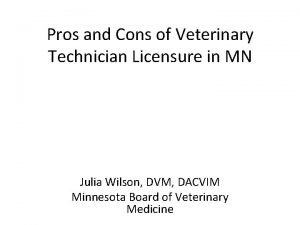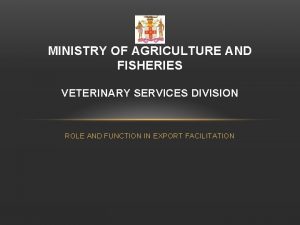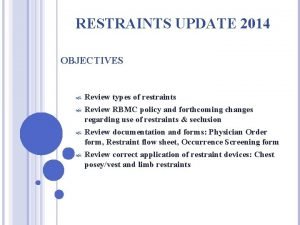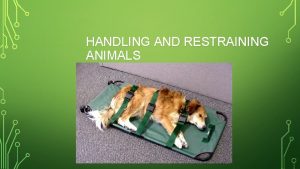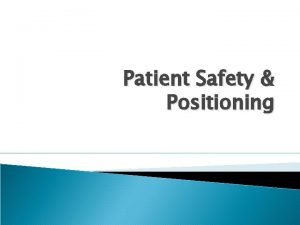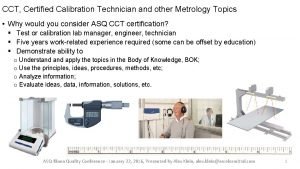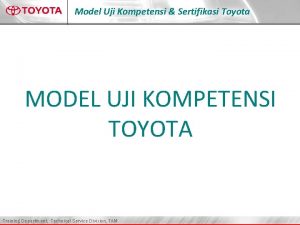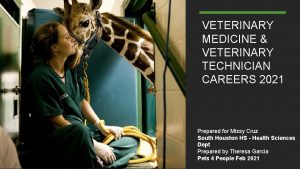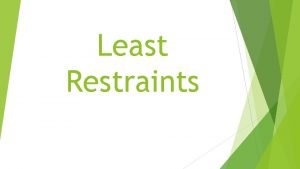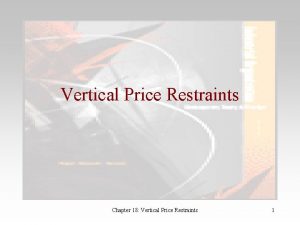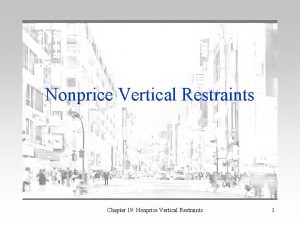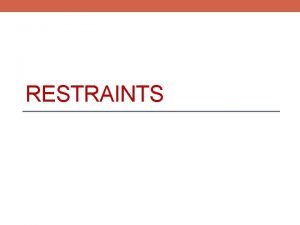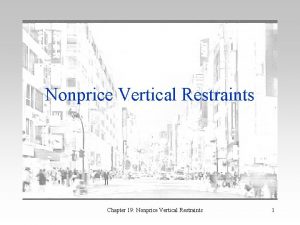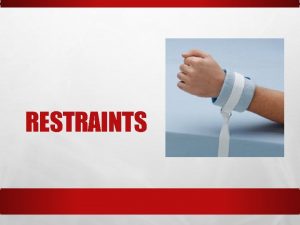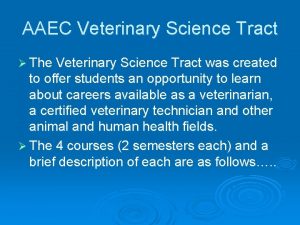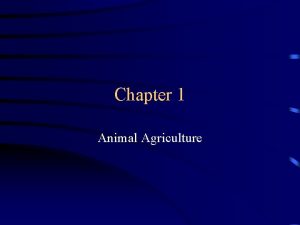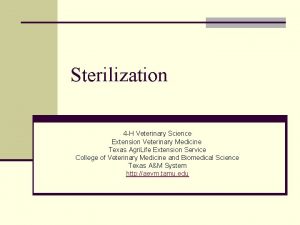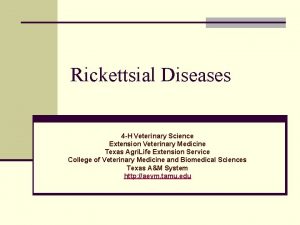Small Animal Restraints Agriculture Science Veterinary Technician 2A






















- Slides: 22

Small Animal Restraints Agriculture Science - Veterinary Technician

� 2(A): explain the importance of safe practice when working with small animals 4(F): describe and practice common methods of handling each species studied � 5(D): demonstrate appropriate methods of handling a variety of animal behavioral situations Small Animal Management & Veterinary Medical Applications

� 9 (D) place and restrain small animals on table; (E) apply safety muzzles and Elizabethan collars; (F) demonstrate proper use of restraint poles � 10 (A) discuss safety purposes of proper restraint to prevent harm to the patient and handler; (B) discuss the importance of proper restraint during veterinary treatments; (C) demonstrate proper restraint methods for a variety of different animals species Intro to Veterinarian Assistant Technology

�Prevents people from getting hurt �Minimizes animal’s chances of injury �Reduces stress for the animal �Sets an example to others of how to properly handle animals Benefits of Proper Animal Handling

�A protective medical device worn by an animal to allow its wounds and injuries to heal �E-collars for Cats �E-collars for Dogs Elizabethan Collars (E-collars)

�Verbal ◦ Commands such as “Sit”, “Stay”, “Down” �Physical ◦ Restraint Pole ◦ Leash ◦ Your hand ◦ Muzzle ◦ Towel Types of Restraint

�A fastening or covering for the mouth of an animal used to prevent eating or biting � Apply a muzzle if animal has had a history of biting � Using a muzzle could reduce the possibility of using additional restraint later � Gauze can be fashioned into a muzzle Muzzles

Basket Style Muzzle Fabric Muzzle � Best � Often type to use for long periods of time � Allows the animal to open its mouth slightly to pant, drink, or vomit used at vet’s � Restricts the animal’s ability to pant � Easy to put on and take off � Comfortable and secure Types of Muzzles

Making a Gauze Muzzle

�Also known as control poles �Used as a last resort at vet clinics �Helps with an aggressive animal �Has a rigid pole to give the user distance from the animal �Animal may flail violently after capture �How to use a Control Pole Restraint Poles

�Used as makeshift restraining devices �Can also help capture animals �If thrown over the animal’s head, the towel can prevent it from seeing and anticipating movements �Helps protect handler’s hands from sharp claws or teeth Towel

�A line for leading or restraining an animal �Placed around the animal’s neck �Do not drag an animal with a leash �However sometimes a quick tug will get an animal to walk �If animal refuses to wear a leash, carry it �Removing a dog from its cage with a leash Leash

�Place one arm in front of the animal’s chest and the other behind its back legs �Animals heavier than 50 pounds should be carried by two people ◦ One person positions arms behind the front legs, under the animal’s chest ◦ The other holds the animal under its abdomen, in front of its hind legs Carrying an Animal

�Carry the animal in a manner that will allow you to increase the amount of restraint quickly �Animal is supported by handler’s arm while its front leg is loosely grasped �Hold the animal’s head to detract its ability to escape Carrying Smaller Animals

� Crouch down to their level but maintain the ability to move away if necessary � Do not approach from behind � Avoid direct eye contact � Get the pet’s attention and encourage it to come forward by calling its name � Talk in soothing tones � Pat your leg to motion the animal towards you � Extend hand, palm down, for the animal to sniff Approaching an Animal

�Often needed to safely examine animals �Restraint Bag �Positional Restraint ◦ Lateral Recumbency (Recumbency means to be lying down) ◦ Sternal Recumbency (Sternal concerns the sternum) Restraining an Animal

�Used to restrain small animals �Has zippers that can be used to expose one body part at a time �Can be replaced by a towel if necessary Restraint Bag

�Place animal on its side �Put elbow over neck and hold the leg closest to the table �Try to keep limbs close to the body �If animal struggles, apply more pressure to stay in control �Lessen the pressure when the animal stops struggling �Watch a video of the process Lateral Recumbency

� Place animal on the examination table in a standing position � Force patient to sit down by applying pressure to hips � Apply pressure to the shoulder with one hand the back with the forearm so that the animal is lying down � Hold the animal’s leg at the elbow to prevent its front leg from pulling back Sternal Recumbency

�Drugs may be necessary so that the vet can safely examine the patient if it is: ◦ Aggressive ◦ Stressed/Worked up ◦ Extremely uncooperative �Sedation or general anesthesia may be used �Ask a staff member to determine if sedation is needed Drugs

�Use as little restraint as possible without giving up your control �Excessive restraint may cause animal to become stubborn �Talk to the animal in a quiet, soothing tone throughout examination �Do not make any sudden movements Things to Remember

�Safe Restraint Methods – lateral incumbency, muzzles �Creating a Muzzle from Gauze �Using a Control Pole (Skip to 2: 45) More Links
 Pros and cons of being a veterinary technician
Pros and cons of being a veterinary technician Ministry of agriculture veterinary services
Ministry of agriculture veterinary services Procedure of mummy restraint
Procedure of mummy restraint Violent vs nonviolent restraints
Violent vs nonviolent restraints Wholesale p-cable seismic system
Wholesale p-cable seismic system Posey soft limb restraints
Posey soft limb restraints Psychological restraint in animals
Psychological restraint in animals Types of restraints
Types of restraints Budget restraints
Budget restraints What is your favorite subject answer?
What is your favorite subject answer? Plant vs animal cells organelles
Plant vs animal cells organelles Plant cell vs animal cell venn diagram
Plant cell vs animal cell venn diagram Animal rights vs animal welfare
Animal rights vs animal welfare What is coring in pharmacy
What is coring in pharmacy How long must a technician evacuating refrigerant
How long must a technician evacuating refrigerant Maximo technician scheduling
Maximo technician scheduling Calibration technician courses
Calibration technician courses 5 healthcare career pathways
5 healthcare career pathways Radar and sonar technician career cluster
Radar and sonar technician career cluster Technician a says that the bulb trade number
Technician a says that the bulb trade number Toyota technician certification
Toyota technician certification Mobile technician app
Mobile technician app Mtm pharmacy technician
Mtm pharmacy technician
